1996 ACURA RL KA9 steering
[x] Cancel search: steeringPage 1032 of 1954
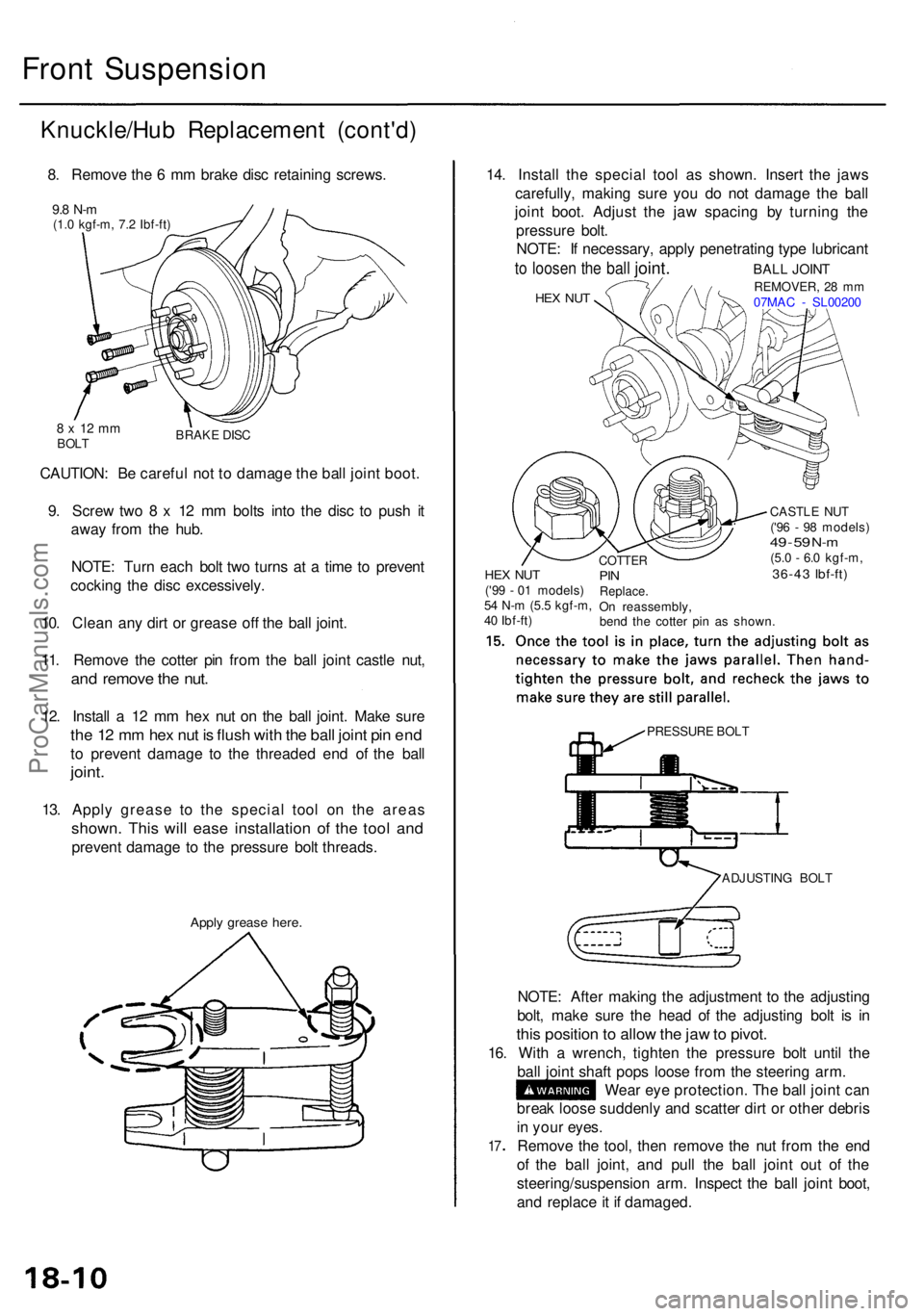
Front Suspensio n
Knuckle/Hu b Replacemen t (cont'd )
8. Remov e th e 6 m m brak e dis c retainin g screws .
9.8 N- m(1.0 kgf-m , 7. 2 Ibf-ft )
CAUTION : B e carefu l no t t o damag e th e bal l join t boot .
9 . Scre w tw o 8 x 1 2 m m bolt s int o th e dis c t o pus h i t
awa y fro m th e hub .
NOTE : Tur n eac h bol t tw o turn s a t a tim e t o preven t
cockin g th e dis c excessively .
10 . Clea n an y dir t o r greas e of f th e bal l joint .
11 . Remov e th e cotte r pi n fro m th e bal l join t castl e nut ,
and remov e th e nut .
12. Instal l a 12 m m he x nu t o n th e bal l joint . Mak e sur e
the 1 2 m m he x nu t i s flus h wit h th e bal l join t pi n en d
to preven t damag e t o th e threade d en d o f th e bal l
joint .
13. Appl y greas e t o th e specia l too l o n th e area s
shown . Thi s wil l eas e installatio n o f th e too l an d
preven t damag e t o th e pressur e bol t threads .
Apply greas e here .
ADJUSTIN G BOL T
NOTE : Afte r makin g th e adjustmen t t o th e adjustin g
bolt , mak e sur e th e hea d o f th e adjustin g bol t i s i n
thi s positio n to allo w th e ja w to pivot .
16. Wit h a wrench , tighte n th e pressur e bol t unti l th e
bal l join t shaf t pop s loos e fro m th e steerin g arm .
Wea r ey e protection . Th e bal l join t ca n
brea k loos e suddenl y an d scatte r dir t o r othe r debri s
i n you r eyes .
Remov e th e tool , the n remov e th e nu t fro m th e en d
o f th e bal l joint , an d pul l th e bal l join t ou t of the
steering/suspensio n arm . Inspec t th e bal l join t boot ,
an d replac e it i f damaged .
17
HE X NU TREMOVER , 2 8 m m
07MA C - SL0020 0
14. Instal l th e specia l too l a s shown . Inser t th e jaw s
carefully , makin g sur e yo u d o no t damag e th e bal l
join t boot . Adjus t th e ja w spacin g b y turnin g th e
pressur e bolt .
NOTE : I f necessary , appl y penetratin g typ e lubrican t
to loose n the bal l joint . BALL JOIN T
HEX NU T('99 - 0 1 models )
5 4 N- m (5. 5 kgf-m ,
4 0 Ibf-ft )
COTTE RPINReplace .On reassembly ,
ben d th e cotte r pi n a s shown .
CASTL
E NU T
('9 6 - 9 8 models )
49 - 5 9 N- m(5. 0 - 6. 0 kgf-m ,36-43 Ibf-ft )
PRESSUR E BOL T
8 x 1 2 m mBOL T BRAK
E DIS C
ProCarManuals.com
Page 1190 of 1954
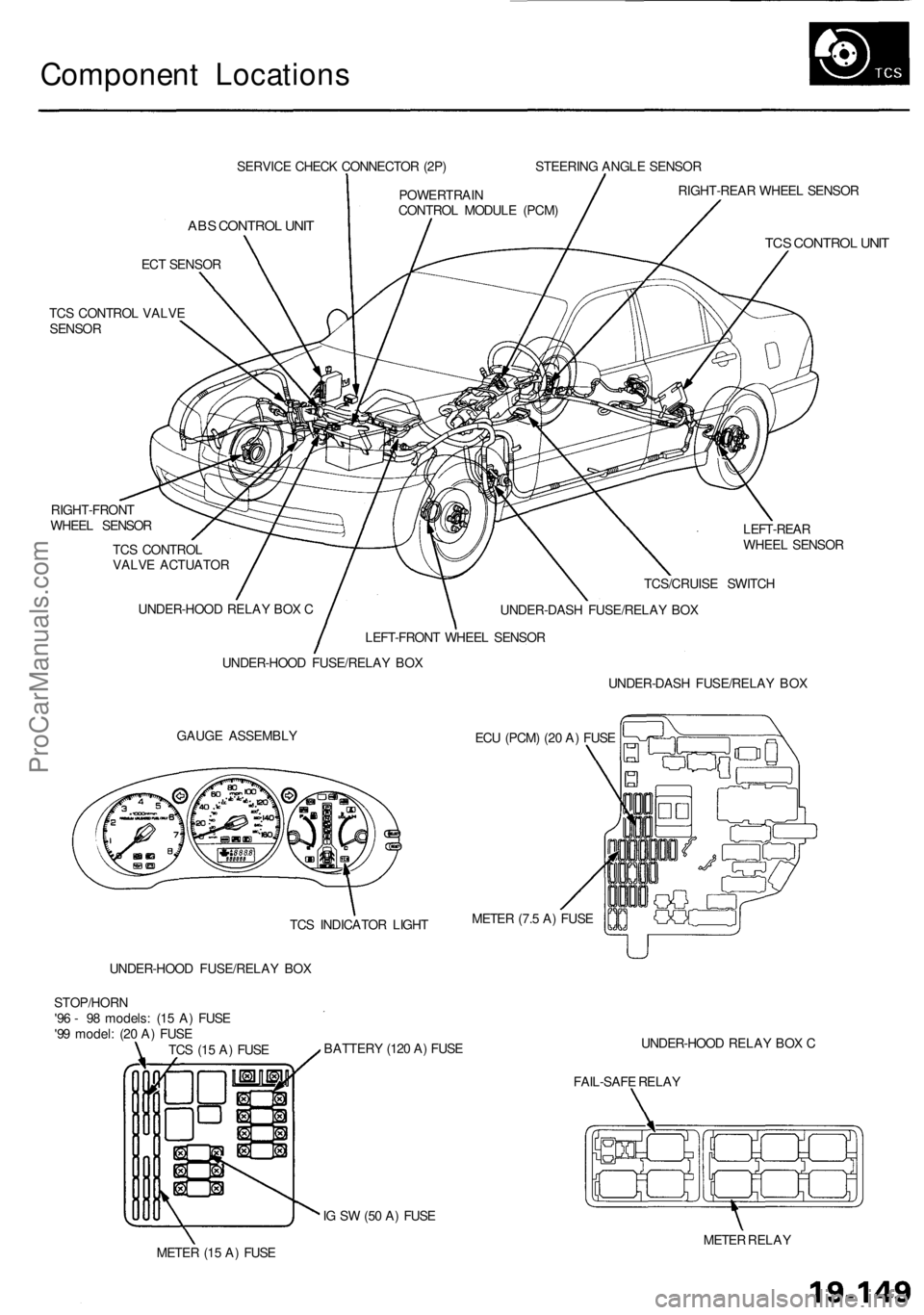
Component Locations
SERVICE CHECK CONNECTOR (2P)
ABS CONTROL UNIT
ECT SENSOR
TCS CONTROL VALVE
SENSOR
RIGHT-FRONT
WHEEL SENSOR
TCS CONTROL
VALVE ACTUATOR
LEFT-REAR
WHEEL SENSOR
GAUGE ASSEMBLY
ECU (PCM) (20 A) FUSE
UNDER-HOOD FUSE/RELAY BOX
BATTERY (120 A) FUSE
UNDER-HOOD RELAY BOX C
FAIL-SAFE RELAY
IG SW (50 A) FUSE
METER (15 A) FUSE
METER RELAY
TCS (15 A) FUSE
STOP/HORN
'96 - 98 models: (15 A) FUSE
'99 model: (20 A) FUSE
UNDER-HOOD FUSE/RELAY BOX
UNDER-HOOD RELAY BOX C
LEFT-FRONT WHEEL SENSOR
POWERTRAIN
CONTROL MODULE (PCM)
STEERING ANGLE SENSOR
RIGHT-REAR WHEEL SENSOR
TCS CONTROL UNIT
TCS/CRUISE SWITCH
UNDER-DASH FUSE/RELAY BOX
UNDER-DASH FUSE/RELAY BOX
METER (7.5 A) FUSE
TCS INDICATOR LIGHTProCarManuals.com
Page 1191 of 1954
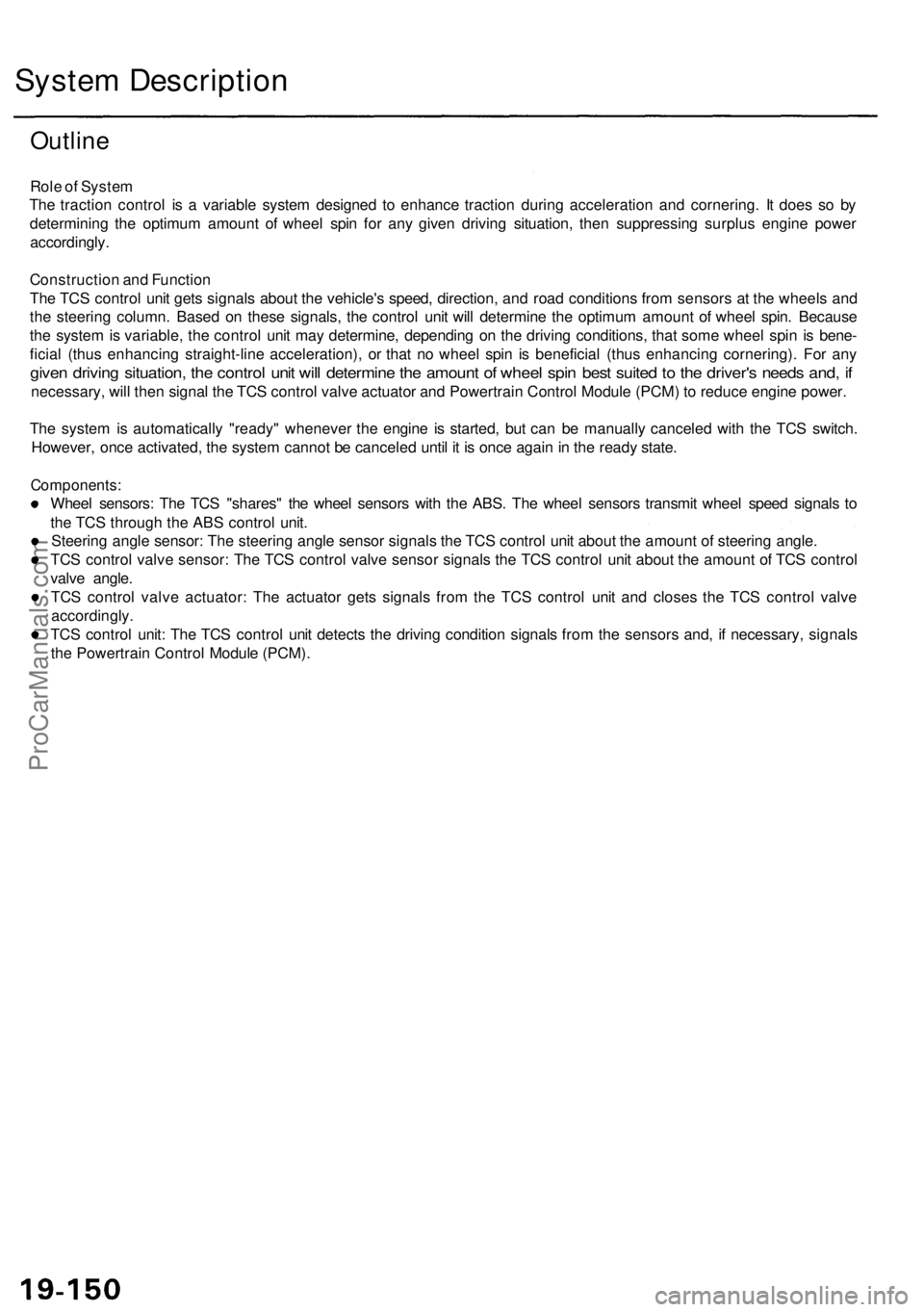
System Description
Outline
Role of System
The traction control is a variable system designed to enhance traction during acceleration and cornering. It does so by
determining the optimum amount of wheel spin for any given driving situation, then suppressing surplus engine power
accordingly.
Construction and Function
The TCS control unit gets signals about the vehicle's speed, direction, and road conditions from sensors at the wheels and
the steering column. Based on these signals, the control unit will determine the optimum amount of wheel spin. Because
the system is variable, the control unit may determine, depending on the driving conditions, that some wheel spin is bene-
ficial (thus enhancing straight-line acceleration), or that no wheel spin is beneficial (thus enhancing cornering). For any
given driving situation, the control unit will determine the amount of wheel spin best suited to the driver's needs and, if
necessary, will then signal the TCS control valve actuator and Powertrain Control Module (PCM) to reduce engine power.
The system is automatically "ready" whenever the engine is started, but can be manually canceled with the TCS switch.
However, once activated, the system cannot be canceled until it is once again in the ready state.
Components:
Wheel sensors: The TCS "shares" the wheel sensors with the ABS. The wheel sensors transmit wheel speed signals to
the TCS through the ABS control unit.
Steering angle sensor: The steering angle sensor signals the TCS control unit about the amount of steering angle.
TCS control valve sensor: The TCS control valve sensor signals the TCS control unit about the amount of TCS control
valve angle.
TCS control valve actuator: The actuator gets signals from the TCS control unit and closes the TCS control valve
accordingly.
TCS control unit: The TCS control unit detects the driving condition signals from the sensors and, if necessary, signals
the Powertrain Control Module (PCM).ProCarManuals.com
Page 1192 of 1954

Construction and Function
TCS Control unit
Driving Control
When the drive wheel speed exceeds the vehicle speed by a given amount, the TCS control unit judges that the drive
wheels are slipping, and it outputs the traction control signal to reduce engine power.
Handling Control
Based on signals about right and left driven wheel rotational speeds, the control unit calculates the vehicle's "yaw" rate
(the turn rate of the vehicle's body). Based on signals from the steering angle sensor, the control unit also calculates the
yaw rate expected by the driver. If the difference between actual and expected yaw rates is substantial — that is, if the
direction of the vehicle's body will exceed the driver's expected line — the control unit signals the TCS control valve actu-
ator and PCM, thus reducing engine power and maintaining the expected line.
Rough Road Control
Based on signals from the wheel sensors, the control unit detects a rough road based on frequency of wheel rotational
vibration. The control unit then signals the TCS control valve actuator and PCM to relax engine power, thus improving
acceleration efficiency.
Grip Control
Based on signals about wheel speed and yaw rate, the control unit determines the efficiency of the grip of the tires on the
road and signals the TCS control valve actuator and PCM to relax engine power if necessary, thus improving grip.
Main Control BlockProCarManuals.com
Page 1195 of 1954
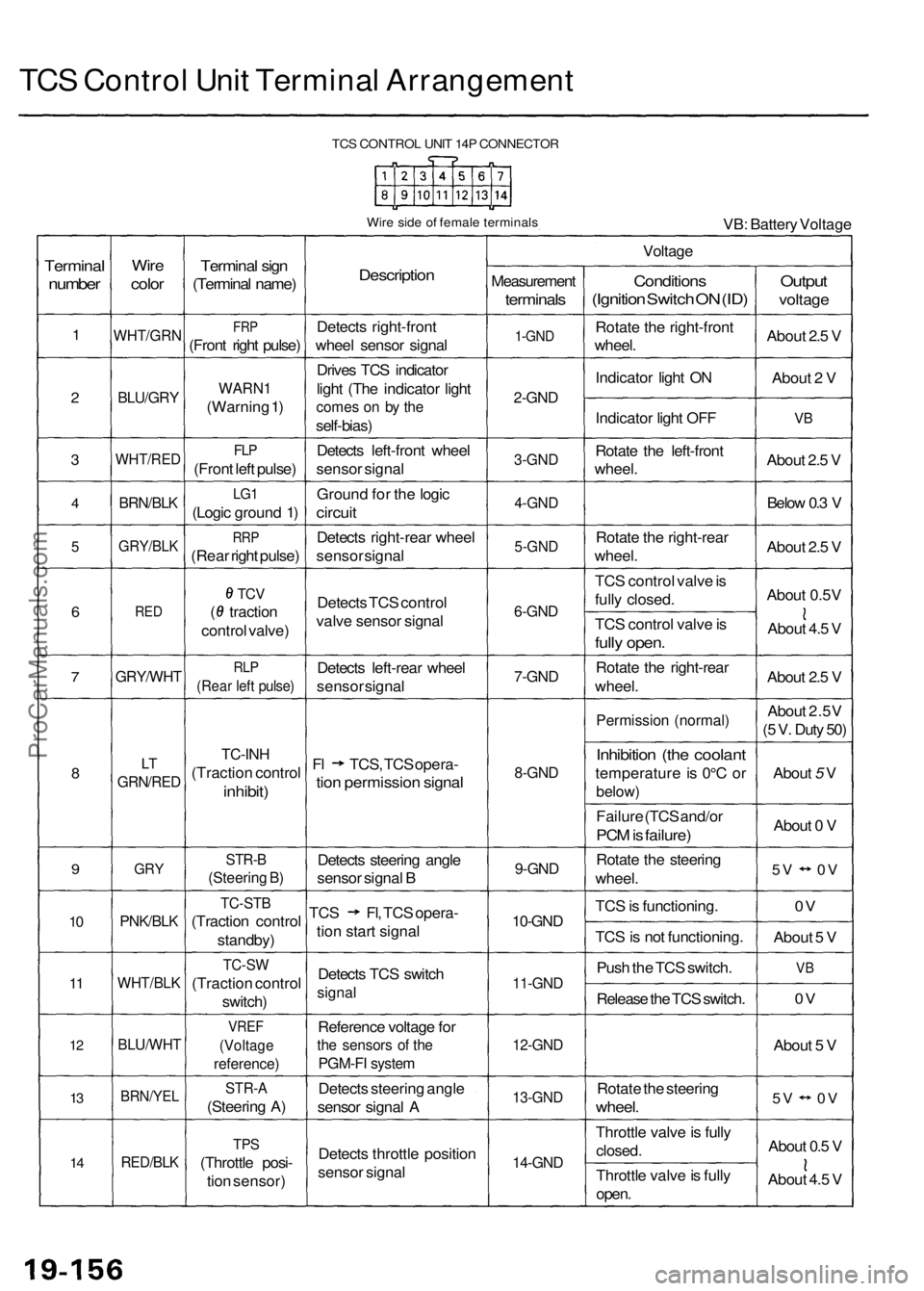
TCS Control Unit Terminal Arrangement
TCS CONTROL UNIT 14P CONNECTOR
Wire side of female terminals
VB: Battery Voltage
Terminal
number
1
2
3
4
5
6
7
8
9
10
11
12
13
14
Wire
color
WHT/GRN
BLU/GRY
WHT/RED
BRN/BLK
GRY/BLK
RED
GRY/WHT
LT
GRN/RED
GRY
PNK/BLK
WHT/BLK
BLU/WHT
BRN/YEL
RED/BLK
Terminal sign
(Terminal name)
FRP
(Front right pulse)
WARN1
(Warning 1)
FLP
(Front left pulse)
LG1
(Logic ground 1)
RRP
(Rear right pulse)
TCV
( traction
control valve)
RLP
(Rear left pulse)
TC-INH
(Traction control
inhibit)
STR-B
(Steering B)
TC-STB
(Traction control
standby)
TC-SW
(Traction control
switch)
VREF
(Voltage
reference)
STR-A
(Steering A)
TPS
(Throttle posi-
tion sensor)
Description
Detects right-front
wheel sensor signal
Drives TCS indicator
light (The indicator light
comes on by the
self-bias)
Detects left-front wheel
sensor signal
Ground for the logic
circuit
Detects right-rear wheel
sensor signal
Detects TCS control
valve sensor signal
Detects left-rear wheel
sensor signal
Fl TCS, TCS opera-
tion permission signal
Detects steering angle
sensor signal B
TCS Fl, TCS opera-
tion start signal
Detects TCS switch
signal
Reference voltage for
the sensors of the
PGM-FI system
Detects steering angle
sensor signal A
Detects throttle position
sensor signal
Voltage
Measurement
terminals
1-GND
2-GND
3-GND
4-GND
5-GND
6-GND
7-GND
8-GND
9-GND
10-GND
11-GND
12-GND
13-GND
14-GND
Conditions
(Ignition Switch ON (ID)
Rotate the right-front
wheel.
Indicator light ON
Indicator light OFF
Rotate the left-front
wheel.
Rotate the right-rear
wheel.
TCS control valve is
fully closed.
TCS control valve is
fully open.
Rotate the right-rear
wheel.
Permission (normal)
Inhibition (the coolant
temperature is 0°C or
below)
Failure (TCS and/or
PCM is failure)
Rotate the steering
wheel.
TCS is functioning.
TCS is not functioning.
Push the TCS switch.
Release the TCS switch.
Rotate the steering
wheel.
Throttle valve is fully
closed.
Throttle valve is fully
open.
Output
voltage
About 2.5 V
About 2 V
VB
About 2.5 V
Below 0.3 V
About 2.5 V
About 0.5V
About 4.5 V
About 2.5 V
About 2.5V
(5 V. Duty 50)
About 5 V
About 0 V
5V 0V
0V
About 5 V
VB
0V
About 5 V
5V 0V
About 0.5 V
About 4.5 VProCarManuals.com
Page 1196 of 1954

TCS CONTROL UNIT 20P CONNECTOR
Wire side of female terminals
VB: Battery Voltage
Terminal
number
1
2
4
5
6
9
10
11
12
13
14
15
16
17
20
Wire
color
BLK/YEL
GRN/RED
BLU
PNK/BLU
BLK/WHT
BLK
BRN/WHT
GRN/WHT
BLU
GRN/ORN
BLK/ORN
BRN/BLK
WHT/BLU
BLU/GRY
GRN
BRN
Terminal sign
(Terminal name)
IG1
(Ignition 1)
PARK
(Parking)
SCS
(Service check
signal)
STR-GND
(Steering ground)
AT-SHIFT
(AT shift)
FSR
(Fail-safe relay)
PMG
(Power motor
Ground)
VPM
(Voltage power
motor)
STOP
(Stop)
NEP (Engine
speed pulse)
BARO
(Barometric)
TC-FC
(Traction control
fuel cut)
LG2
(Logic ground 2)
STR-VCC (Steer-
ing power supply)
WARN2
(Warning 2)
SH-MOT
(Shield motor)
MOT +
(Motor +)
MOT-
(Motor -)
Description
Detects ignition switch
IG1 signal
Detects parking brake
switch signal
Detects service check
connector signal
(Diagnostic trouble
code indication)
Ground for the steering
angle sensor
Detects A/T shift posi-
tion signal
Drives fail-safe relay
Power ground for the
TCS control valve
actuator motor
Power source for the
TCS control valve
actuator motor
Detects brake pedal
position switch signal
Detects engine speed
signal
Detects barometric
sensor signal
TCS Fl, Fuel cut
(torque down) signal
Ground for the logic
circuit
Power source for the
steering angle sensor
Drives TCS indicator light
(The indicator light comes
on by the self-bias)
Shield for the TCS con-
trol valve actuator motor
Drives TCS control
valve actuator motor
Drives TCS control
valve actuator motor
Measurement
terminals
1-GND
2
3-GND
4-GND
5-GND
6-GND
9-GND
10-GND
11-GND
12-GND
13-GND
14-GND
15-GND
16-GND
17-GND
19-20
20-19
Voltage
Conditions
(Ignition Switch ON (II))
Depress the parking
brake pedal.
Release the parking
brake pedal.
SCS service connector
connected.
SCS service connector
disconnected.
Shift the transmission
to position, then
start the engine.
Start the engine.
Start the engine.
Brake pedal depressed.
Brake pedal released.
Engine idling
TCS is functioning,
(maximum fuel cut)
TCS is not functioning.
Indicator light ON
Indicator light OFF
TCS is functioning.
TCS is not functioning.
TCS is functioning.
TCS is not functioning.
Output
voltage
VB
Below 0.6 V
VB
0V
5V
Below 0.3V
About 4V
(5V 0V)
VB
1.5V
Below 0.3 V
0V
VB
VB
0V
About 6V
(12V
0V)
About 3 V
About 1.5V
About 4.5 V
(5 V,
PWM)
Below 0.3V
About 5 V
About 2 V
VB
VB
0V
VB
0VProCarManuals.com
Page 1207 of 1954
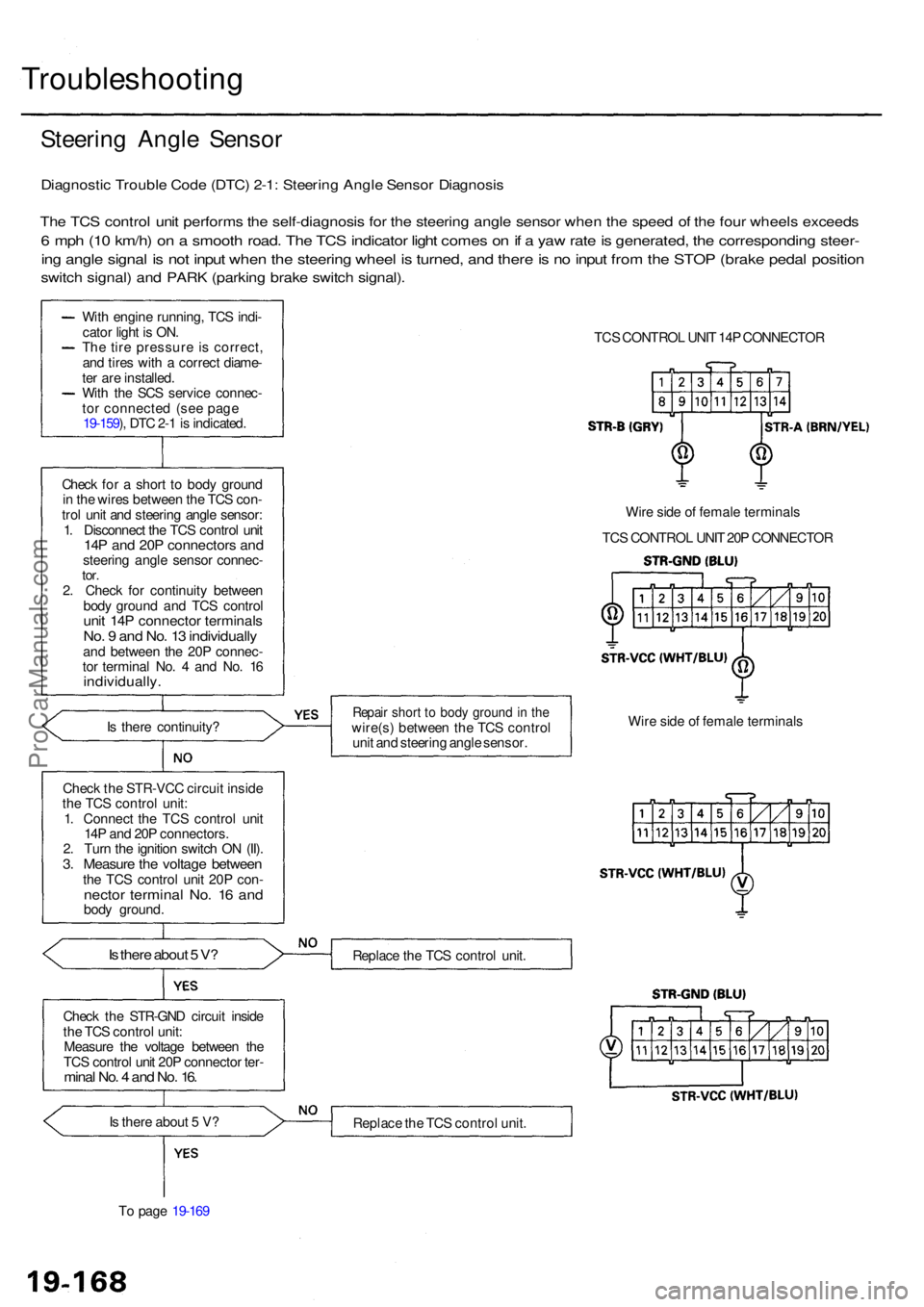
Troubleshooting
Steering Angl e Senso r
Diagnosti c Troubl e Cod e (DTC ) 2-1 : Steerin g Angl e Senso r Diagnosi s
The TC S contro l uni t perform s th e self-diagnosi s fo r th e steerin g angl e senso r whe n th e spee d o f th e fou r wheel s exceed s
6 mp h (1 0 km/h ) o n a smoot h road . Th e TC S indicato r ligh t come s o n if a ya w rat e is generated , th e correspondin g steer -
ing angl e signa l i s no t inpu t whe n th e steerin g whee l i s turned , an d ther e is n o inpu t fro m th e STO P (brak e peda l positio n
switch signal ) an d PAR K (parkin g brak e switc h signal) .
With engin e running , TC S indi -
cato r ligh t i s ON .
Th e tir e pressur e i s correct ,
an d tire s wit h a correc t diame -
te r ar e installed .
Wit h th e SC S servic e connec -
to r connecte d (se e pag e
19-159 ), DT C 2- 1 is indicated .
Chec k fo r a shor t t o bod y groun d
i n th e wire s betwee n th e TC S con -
tro l uni t an d steerin g angl e sensor :
1 . Disconnec t th e TC S contro l uni t
14P an d 20 P connector s an dsteerin g angl e senso r connec -tor.2. Chec k fo r continuit y betwee n
bod y groun d an d TC S contro l
unit 14 P connecto r terminal sNo. 9 an d No . 1 3 individuall yand betwee n th e 20 P connec -
to r termina l No . 4 an d No . 1 6
individually .
Is ther e continuity ?
Chec k th e STR-VC C circui t insid e
th e TC S contro l unit :
1 . Connec t th e TC S contro l uni t
14 P an d 20 P connectors .
2 . Tur n th e ignitio n switc h O N (II) .
3. Measur e th e voltag e betwee nthe TC S contro l uni t 20 P con -necto r termina l No . 1 6 an dbod y ground .
Is ther e abou t 5 V ?
Chec k th e STR-GN D circui t insid e
th e TC S contro l unit :
Measur e th e voltag e betwee n th e
TC S contro l uni t 20 P connecto r ter -
mina l No . 4 an d No . 16 .
Is ther e abou t 5 V ?
T o pag e 19-16 9 TC
S CONTRO L UNI T 14 P CONNECTO R
Wir e sid e o f femal e terminal s
TC S CONTRO L UNI T 20 P CONNECTO R
Repair shor t t o bod y groun d in th ewire(s ) betwee n th e TC S contro l
uni t an d steerin g angl e sensor . Wir
e sid e o f femal e terminal s
Replac e th e TC S contro l unit .
Replac e th e TC S contro l unit .
ProCarManuals.com
Page 1209 of 1954
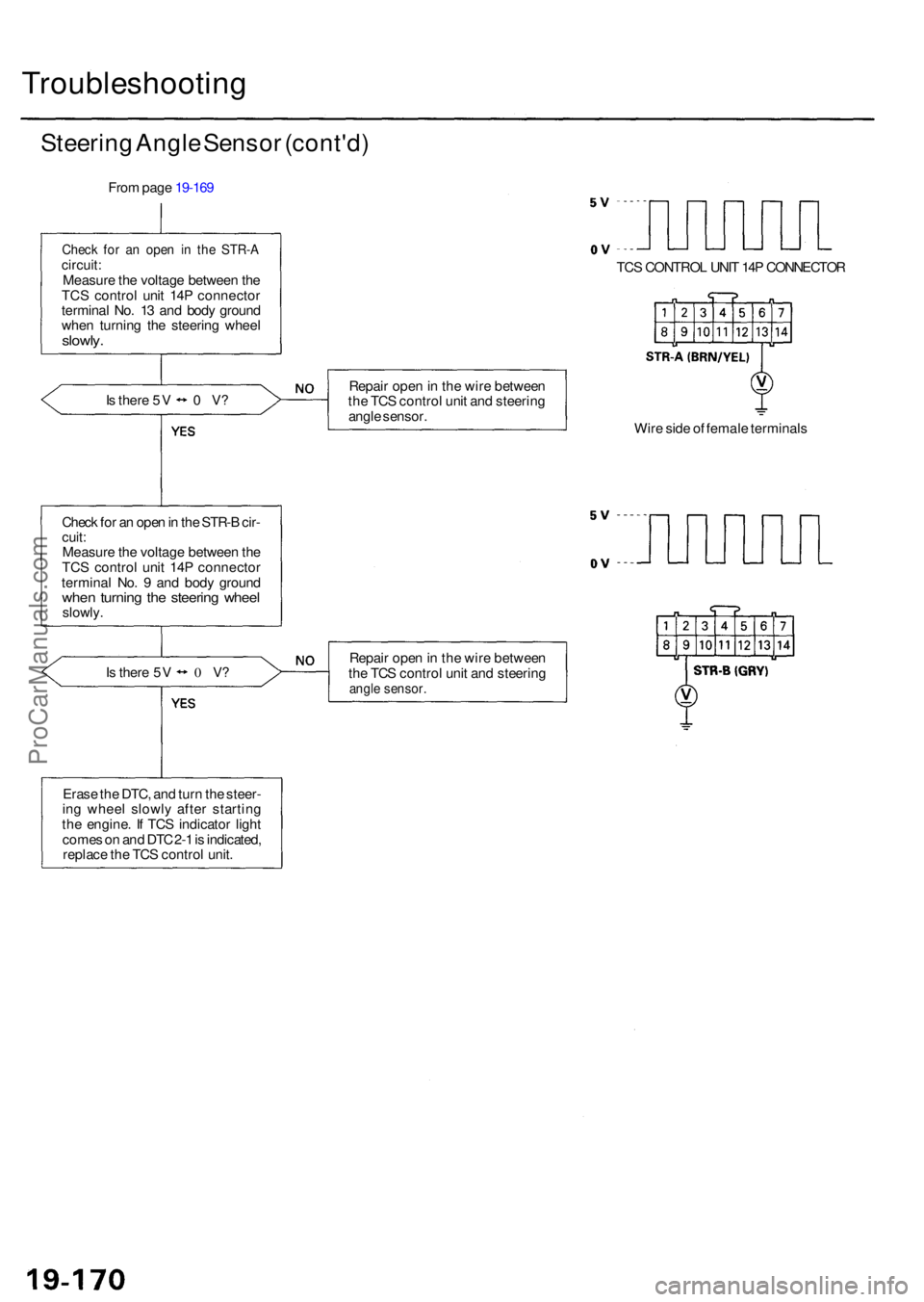
Troubleshooting
Steering Angl e Senso r (cont'd )
From pag e 19-16 9
Chec k fo r a n ope n i n th e STR- Acircuit:Measur e th e voltag e betwee n th e
TC S contro l uni t 14 P connecto r
termina l No . 1 3 an d bod y groun d
whe n turnin g th e steerin g whee l
slowly.
Is ther e 5 V 0 V?
Chec k fo r a n ope n in th e STR- B cir -
cuit :Measur e th e voltag e betwee n th e
TC S contro l uni t 14 P connecto r
termina l No . 9 an d bod y groun d
when turnin g th e steerin g whee lslowly .
Is ther e 5 V 0 V? Repai
r ope n in th e wir e betwee n
th e TC S contro l uni t an d steerin g
angl e sensor .
Wire sid e o f femal e terminal s
Repai r ope n in th e wir e betwee n
th e TC S contro l uni t an d steerin gangle sensor .
Erase th e DTC , an d tur n th e steer -
in g whee l slowl y afte r startin g
th e engine . I f TC S indicato r ligh t
come s o n an d DT C 2- 1 is indicated ,
replac e th e TC S contro l unit . TC
S CONTRO L UNI T 14 P CONNECTO R
ProCarManuals.com